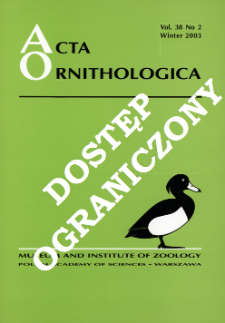
Obiekt
Tytuł: Can timing and synchronisation of breeding affect chick mortality in the great cormorant Phalacrocorax carbo?
Twórca:
Stempniewicz, Lech (1949– ) ; Goc, Michał (1949– ) ; Bzoma, Szymon ; Nitecki, Czesław ; Iliszko, Lech
Data wydania/powstania:
Typ zasobu:
Inny tytuł:
Acta Ornithologica, vol. 35, no. 1 ; Czy synchronizacja lęgów może wpływać na śmiertelność piskląt kormorana ; Timing and breeding synchronisation influence on chick mortality in the cormorant
Współtwórca:
Polska Akademia Nauk. Muzeum i Instytut Zoologii ; Meeting of the European Ornithologists' Union (2 ; 1999 ; Gdańsk)
Wydawca:
Muzeum i Instytut Zoologii PAN
Miejsce wydania:
Opis:
Ref. wygłoszony na Second Meeting of the European Ornithologists' Union ; Bibliogr. s. 37-38 ; S. [33]-39 : il. ; 27 cm ; Streszcz. pol.
Typ obiektu:
Abstrakt:
In 1996, following a relatively severe and prolonged winter, Great Cormorants started to breed at the Kąty Rybackie colony (NE Poland) one month later than in 1995 but breeding finished at the same time in both years. The estimated total food consumption of the Cormorants was lower during the shorter and more synchronised 1996 breeding season (737 tonnes) than in 1995 (805 tonnes) despite the larger population present in 1996 (5929 pairs) than in 1995 (4942). However, during the period of peak energy need in June the estimated total daily food consumption of Cormorants present in the colony was about 2 tonnes higher in 1996. In June 1996, after a couple of windy days, 24.3% of chicks died and the total fledging success was lower (2.19 fledglings/nest) than in 1995 (2.45). The observed mass chick mortality could be due to the combined effect of strong breeding synchronisation, decreased food availability, and increased costs of foraging due to strong winds. Large breeding colonies of Cormorants can only function successfully when the suitable breeding period is prolonged and breeding can start early. Long-term climate change due to global warming could have favoured the observed Cormorant population increase during the last decades and its expansion into NE Europe. Asynchrony could be adaptive towards alleviating the food requirements of both individual broods and the whole colony.
Czasopismo/Seria/cykl:
Tom:
Zeszyt:
Strona pocz.:
Strona końc.:
Szczegółowy typ zasobu:
Artykuł ; Materiały konferencyjne
Format:
Identyfikator zasobu:
Źródło:
MiIZ PAN, patrz sygn. czas. P.257, Vol. 35, No 1 ; MiIZ PAN, patrz sygn. czas. P.4568, Vol. 35, No 1 ; kliknij tutaj, żeby przejść
Język:
Prawa:
Prawa zastrzeżone - dostęp ograniczony
Zasady wykorzystania:
Digitalizacja:
Muzeum i Instytut Zoologii Polskiej Akademii Nauk
Lokalizacja oryginału:
Biblioteka Muzeum i Instytutu Zoologii PAN
Dofinansowane ze środków:
Program Operacyjny Innowacyjna Gospodarka, lata 2010-2014, Priorytet 2. Infrastruktura strefy B + R ; Unia Europejska. Europejski Fundusz Rozwoju Regionalnego
Dostęp:
Kolekcje, do których przypisany jest obiekt:
- Muzeum i Instytut Zoologii PAN > Czasopisma
- Muzeum i Instytut Zoologii PAN > Wydawnictwa MiIZ PAN > Acta Ornithologica
Data ostatniej modyfikacji:
2 paź 2020
Data dodania obiektu:
22 maj 2014
Liczba pobrań / odtworzeń:
62
Wszystkie dostępne wersje tego obiektu:
https://rcin.org.pl/miiz/publication/61260
Wyświetl opis w formacie RDF:
Wyświetl opis w formacie RDFa:
Wyświetl opis w formacie OAI-PMH:
Obiekty Podobne
Grieco, Fabrizio (1969– ) Kortlandt, Adriaan (1918–2009)
Goc, Michał (1949– )
Kéler, Stefan von (1897–1967)
Kopij, Grzegorz
Stempniewicz, Lech (1949– )
Stempniewicz, Lech (1949– )
Jenni, Lukas

 INSTYTUT ARCHEOLOGII I ETNOLOGII POLSKIEJ AKADEMII NAUK
INSTYTUT ARCHEOLOGII I ETNOLOGII POLSKIEJ AKADEMII NAUK
 INSTYTUT BADAŃ LITERACKICH POLSKIEJ AKADEMII NAUK
INSTYTUT BADAŃ LITERACKICH POLSKIEJ AKADEMII NAUK
 INSTYTUT BADAWCZY LEŚNICTWA
INSTYTUT BADAWCZY LEŚNICTWA
 INSTYTUT BIOLOGII DOŚWIADCZALNEJ IM. MARCELEGO NENCKIEGO POLSKIEJ AKADEMII NAUK
INSTYTUT BIOLOGII DOŚWIADCZALNEJ IM. MARCELEGO NENCKIEGO POLSKIEJ AKADEMII NAUK
 INSTYTUT BIOLOGII SSAKÓW POLSKIEJ AKADEMII NAUK
INSTYTUT BIOLOGII SSAKÓW POLSKIEJ AKADEMII NAUK
 INSTYTUT CHEMII FIZYCZNEJ PAN
INSTYTUT CHEMII FIZYCZNEJ PAN
 INSTYTUT CHEMII ORGANICZNEJ PAN
INSTYTUT CHEMII ORGANICZNEJ PAN
 INSTYTUT FILOZOFII I SOCJOLOGII PAN
INSTYTUT FILOZOFII I SOCJOLOGII PAN
 INSTYTUT GEOGRAFII I PRZESTRZENNEGO ZAGOSPODAROWANIA PAN
INSTYTUT GEOGRAFII I PRZESTRZENNEGO ZAGOSPODAROWANIA PAN
 INSTYTUT HISTORII im. TADEUSZA MANTEUFFLA POLSKIEJ AKADEMII NAUK
INSTYTUT HISTORII im. TADEUSZA MANTEUFFLA POLSKIEJ AKADEMII NAUK
 INSTYTUT JĘZYKA POLSKIEGO POLSKIEJ AKADEMII NAUK
INSTYTUT JĘZYKA POLSKIEGO POLSKIEJ AKADEMII NAUK
 INSTYTUT MATEMATYCZNY PAN
INSTYTUT MATEMATYCZNY PAN
 INSTYTUT MEDYCYNY DOŚWIADCZALNEJ I KLINICZNEJ IM.MIROSŁAWA MOSSAKOWSKIEGO POLSKIEJ AKADEMII NAUK
INSTYTUT MEDYCYNY DOŚWIADCZALNEJ I KLINICZNEJ IM.MIROSŁAWA MOSSAKOWSKIEGO POLSKIEJ AKADEMII NAUK
 INSTYTUT PODSTAWOWYCH PROBLEMÓW TECHNIKI PAN
INSTYTUT PODSTAWOWYCH PROBLEMÓW TECHNIKI PAN
 INSTYTUT SLAWISTYKI PAN
INSTYTUT SLAWISTYKI PAN
 SIEĆ BADAWCZA ŁUKASIEWICZ - INSTYTUT TECHNOLOGII MATERIAŁÓW ELEKTRONICZNYCH
SIEĆ BADAWCZA ŁUKASIEWICZ - INSTYTUT TECHNOLOGII MATERIAŁÓW ELEKTRONICZNYCH
 MUZEUM I INSTYTUT ZOOLOGII POLSKIEJ AKADEMII NAUK
MUZEUM I INSTYTUT ZOOLOGII POLSKIEJ AKADEMII NAUK
 INSTYTUT BADAŃ SYSTEMOWYCH PAN
INSTYTUT BADAŃ SYSTEMOWYCH PAN
 INSTYTUT BOTANIKI IM. WŁADYSŁAWA SZAFERA POLSKIEJ AKADEMII NAUK
INSTYTUT BOTANIKI IM. WŁADYSŁAWA SZAFERA POLSKIEJ AKADEMII NAUK
































